
December 13, 2016 — Coupling data mining of adverse event reports and electronic health records with targeted laboratory experiments, researchers found a way to identify and confirm previously unknown drug interactions, according to a new study. The study was published in October in the Journal of the American College of Cardiology.
Drug-drug interactions account for a significant proportion of side effects and hospitalizations, but they are often very difficult to predict.
Researchers in the new study used the data mining approach to discover that together, two commonly used drugs – a popular over-the-counter medication for heartburn relief and an antibiotic used to prevent and treat infection – were associated with an increased risk of acquired long QT syndrome, which can lead to life-threatening arrhythmias or problems with the way the heart beats.
“Doctors must often rely on a wait-and-see approach to monitor safety when patients are taking multiple medicines. By using large datasets of clinical records available from the Food and Drug Administration and in electronic health records at our hospital, we were able to use data science to accurately identify a previously unexpected interaction from among millions of possibilities, which would not have been suspected using current surveillance methods,” said Nicholas Tatonetti, Ph.D., Herbert Irving Assistant Professor, Department of Biomedical Informatics at Columbia University and one of the study’s authors.
The researchers chose to investigate QT interval prolongation because of its importance in drug safety and drug development. The QT interval is the measure of the time between the start and the end of the cardiac electrical cycle as recorded by the electrocardiogram. With QT prolongation, it takes longer to transmit electrical signals through the heart muscle, which can lead to serious, even fatal, heart rhythm disturbances. “Investigative drugs that have the potential to prolong the QT interval will be withdrawn before they are ever given to a patient; however, no such checks exist for drug-drug interactions and they often go undiscovered for years,” said Tatonetti.
Using an algorithm called Latent Signal Detection, researchers scanned data from two independent databases to investigate possible QT interval-prolonging drug-drug interactions: 1.8 million adverse event reports from the U.S. Food and Drug Administration’s Adverse Event Reporting System and 1.6 million electrocardiograms from 382,221 patients treated at New York-Presbyterian/CUMC between 1996 and 2014. A computer can evaluate millions of data points all at once and flag the most likely drug-drug interactions.
Even with large amounts of data, the association between the drug combination and the prolonged QT interval does not prove the drugs caused this problem. To get more information, researchers then applied more traditional analyses and laboratory experiments to validate the predictions.
In this study, people taking ceftriaxone (a cephalosporin antibiotic) and lansoprazole (a proton pump inhibitor) were 40 percent more likely to have a QT interval above 500 ms, which is the current FDA-stated threshold of clinical concern. Among men taking both of these drugs, QT intervals were 12ms longer than men who took either drug alone. This trend was then validated by cellular data from the electrophysiology experiment, which found that together these drugs block one of the cardiac ion channels responsible for controlling heart rhythm. White women and men appear to be more sensitive to this interaction.
Interestingly, the interaction identified in the data analysis was specific to lansoprazole and ceftriaxone, and not other cephalosporin antibiotics. Even though they share similar chemical structure and mode of action, Tatonetti said, “our algorithm was able to distinguish between one that would cause this interaction (ceftriaxone) and another that would not (cefuroxime). We tested both in the lab and the algorithm was correct in both cases.”
This research comes at a time when an increasing number of Americans are taking multiple prescriptions and over-the-counter medications. All told, nearly 70 percent take at least one prescription drug, and more than half take two, according to a 2013 study published in the Mayo Clinic Proceedings. Among the most commonly prescribed drugs are antibiotics. Twenty percent of patients are on five or more prescription medications. Finding ways to identify potentially harmful interactions is critical.
In an accompanying editorial, Dan M. Roden, M.D., and colleagues wrote that the findings of this study are not robust enough to advise clinicians to avoid this combination in all patients, but it shows that it is important to examine the effects of these drugs individually and in combination in patients.
The editorial said that with an aging population, it is becoming more common for patients to be on multiple medications, making it more important than ever to find a faster. data-driven approach to identifying potential interactions among a vast number of possible drug pairs patients could be taking.
“Solving the methodological challenges of developing approaches to systematically leverage these data sources will be a next frontier in identifying and preventing adverse drug reactions,” the authors said.
While the new study was limited to common drug combinations prescribed in one hospital system, Tatonetti and his team believe that analyses made possible through wider data sharing can be used to look more extensively at potential drug interactions.
“The analyses are relatively rapid and inexpensive to perform and they focus on drug combinations that are actually used together in clinical practice,” Tatonetti said
The study was funded by the National Institutes of Health, National Institute of General Medical Sciences.
For more information: www.onlinejacc.org


 February 15, 2022
February 15, 2022 








